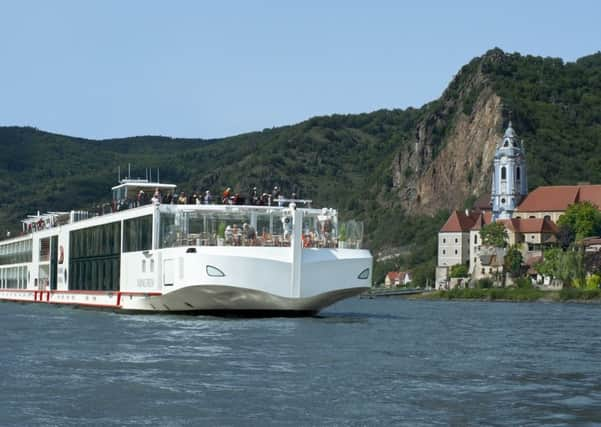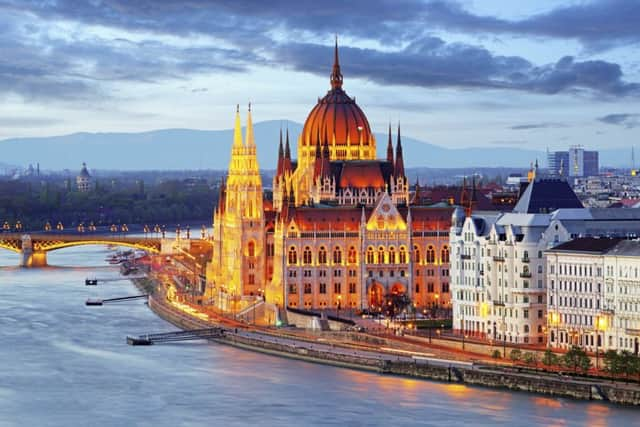Travel: Waltzing along the Danube
This article contains affiliate links. We may earn a small commission on items purchased through this article, but that does not affect our editorial judgement.


Vienna, I discovered, is a hoarder of historical sites. Take for instance the Hofburg Palace. This magnificent building contains the Imperial Apartments, lots of museums with one devoted to the ultra popular Empress Elizabeth (known as ‘Sisi’), the office of the Austrian president, the chapel where the Vienna Boys’ Choir sing and the hall in which the Lipizzan stallions of the Spanish Riding School perform their elegant manoeuvres. That’s a lot to pack into one building.
Our included City Tour excursion was one of the highlights of our visit to the Austrian capital and provided an overview to this ‘City of Waltzes’. Vienna is Europe’s centre of classical music and it seemed that all round town I happened upon references to Vienna’s musical worthies. Haydn, Schubert, Beethoven, Strauss, Mahler, Bruckner and Mozart all lived here at one time or another. One much visited pilgrimage site is the Mozarthaus located on the Domgasse behind St Stephen’s Cathedral and the only surviving residence of Wolfgang Amadeus. Locals refer to it as the ‘Figarohaus’ because he wrote The Marriage of Figaro here. Another is one of Beethoven’s abodes, the Pasqualati House. He moved home a lot because he tended to annoy his landlords with his habit of playing the piano in the middle of the night. He played it very loudly too, due to his deafness. Anyway, most of his winters were spent in this house, now a museum, which he rented from Johann von Pasqualati. The piano on which he composed his Fifth Symphony sits in the main room together with personal artefacts including paintings and musical scores. Exit the building and eagle-eyed fans of classic film The Third Man will spot a doorway from the movie, just alongside.
Advertisement
Hide AdBack on board our cruise ship, there was time to relax briefly in our comfortable, compact verandah cabin which came with all the usual amenities plus a flatscreen TV.


Complimentary wifi is always a bonus and meant I could catch up on emails before heading for dinner in the main restaurant. No need to miss out on the passing scenery here because the room has floor-to-ceiling windows for panoramic views. The menu, which changes daily, features three or four starters and three mains – normally a meat, fish and vegetarian option while ‘always available’ choices include grilled salmon, charbroiled steak and Caesar salad. However on sunny days my favourite place to eat was the Aquavit Terrace, an open air cafe on the bow of the ship where imaginative buffet lunches proved popular with guests. We could also take our meals up to the top sun deck which runs the whole length of the vessel and has a herb garden at one end. This is where to find the shuffleboard court, putting greens and giant chess set too, though views are really the reason most passengers go up there. That and the walking track (12 circuits equal one mile). The logistics of travelling along narrow parts of the river and under low bridges means although river ships are compact they can pack a lot into four decks.
We started our journey on Viking Freya at Nuremberg, Bavaria’s second largest city.
Although badly smashed up in Second World War, it’s nothing short of a miracle that the medieval city walls remain. They stretch for around three miles and feature original gateways with 80 watchtowers. This one-time toy making capital of Europe was also the seat of Nazi propaganda and later, site of the war crimes trials at the Palace of Justice. Our tour took us to Zeppelin Field, the former Nazi Party rally grounds where 100,000 voices once saluted Adolf Hitler. On a lighter note, the Handverkerhof, a kind of ‘medieval mall’ is well worth visiting.
You’ll think you’ve been whisked back to the Middle Ages as you watch craftspeople turning out pewter, glassware, wood carvings and even bread, just as they did aeons ago.


From Nuremberg we sailed to Regensburg, the Danube’s oldest city and birthplace of Pope Benedict XV1 who resigned the papacy in 2013, the only Pope ever to do so. The medieval town centre is a Unesco World Heritage Site. Those of us on the guided city tour saw the 12th century Stone Bridge, a 16-arch engineering marvel; the massive St Peter’s Cathedral which can hold 6,000 people and the Old Town Hall with its sumptuous adornments of tapestries, flags and heraldic designs. There is a Scots Monastery in town too, a Benedictine abbey founded by Hiberno-Scottish missionaries. Our guide also pointed out the Historische Wurstkuche or Historic Sausage Kitchen, which claims to be the oldest continuously open public restaurant in the world and serves around 6,000 sausages daily.
Advertisement
Hide AdThese are traditionally eaten with sauerkraut and mustard – not any old mustard though, but ‘Händlmaier’s Senf’, a sweet mustard usually served with white sausages.
Food on Viking Freya is often themed to the location and no-one goes hungry. Better still, the slower pace means calm conditions, perfect for eating and drinking and for those who are put off the thought of cruising because of sea sickness, river boats are as smooth as they are quiet. Much of the pleasure of river cruising comes during the voyages between cities and since ships berth in a different destination nearly every evening, there is plenty of time to venture further afield.
Advertisement
Hide AdAll too soon we were heading for our final destination of Budapest. We drifted into the city early one morning and berthed close by the ravishingly theatrical Parliament Building.
After breakfast, those who wanted to go on the city tour trooped off the ship to meet the guide. Our tour by coach and on foot covered Budapest’s main sights including Andrassy Avenue known as the Champs-Elysees of Budapest; Heroes’ Square, where two semi-circular arcades hold bronze statues of seven personalities of Hungarian history and we swung by the glorious Opera House too. More leisure time was spent at Fisherman’s Bastion terrace, a flurry of fairytale towers and colonnades with extravagant vistas over the city and the Danube. This is one of Budapest’s most popular tourist attractions, but it’s wise to visit early in the day if you want to get a good viewpoint.
Budapest wears its history, both ancient and more recent, proudly. Later that afternoon, after lunch on board, we walked along the river bank in the warm sunshine, passing by the Shoes on the Danube memorial. The shoes, placed there in memory of Jews who were shot into the Danube during the Second World War, is a poignant reminder of times past. We walked across elegant Elizabeth Bridge too, named after Austro-Hungarian Empress ‘Sisi’ who was as popular in Budapest as she was in Vienna. At night it is prettily illuminated with hundreds of twinkling lights, as indeed are most of Budapest’s main sights.
Although our cruise was at an end it was possibly only the beginning of our romance with Viking River Cruises. For style, comfort and effortless travel, it is the tops.
• An eight-day ‘Romantic Danube’ cruise from Nuremberg to Budapest costs from £1,795pp (based on two people sharing a cabin), including all meals, drinks with lunch and dinner (wine, beer and soft drinks) and six guided tours. Price includes wifi and flights. Cruises take place from April to December, www.vikingrivercruises.co.uk, 0800 319 66 60. Holiday Extras offers a choice of parking at UK airports. To book Edinburgh parking from £29.99 for a week go to www.holidayextras.co.uk